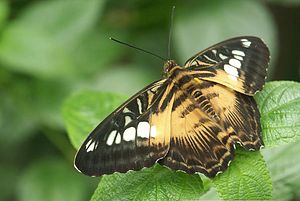Difference between revisions of "AY Honors/Insect/Lepidoptera/es"
From Pathfinder Wiki
< AY HonorsAY Honors/Insect/Lepidoptera/es
(Created page with "Category:Adventist Youth Honors Answer Book/es <noinclude>") |
(Created page with "Species id/es | common_name = Mariposas y polillas | image = Parthenos_sylvia_philippensis.jpg | latin_name = Lepidoptera | order = '''Lepidoptera''' | description = Los lepid...") |
||
| Line 3: | Line 3: | ||
{{ | {{ | ||
| − | Species id | + | Species id/es |
| − | | common_name = | + | | common_name = Mariposas y polillas |
| image = Parthenos_sylvia_philippensis.jpg | | image = Parthenos_sylvia_philippensis.jpg | ||
| latin_name = Lepidoptera | | latin_name = Lepidoptera | ||
| order = '''Lepidoptera''' | | order = '''Lepidoptera''' | ||
| description = | | description = | ||
| − | + | Los lepidópteros se someten a una metamorfosis completa, pasando por un ciclo de vida de cuatro etapas: | |
| − | # | + | # huevo |
| − | # larva/ | + | # larva/oruga |
| − | # pupa/ | + | # pupa/crisálida |
| − | # imago/ | + | # imago/adulto |
The larvae, caterpillars, have a toughened head capsule, chewing mouthparts, and a soft body, that may have hair-like or other projections, 3 pairs of true legs, and additional prolegs (up to 5 pairs). | The larvae, caterpillars, have a toughened head capsule, chewing mouthparts, and a soft body, that may have hair-like or other projections, 3 pairs of true legs, and additional prolegs (up to 5 pairs). | ||
Revision as of 12:55, 18 January 2019
| Lepidoptera (Mariposas y polillas) | |
|---|---|
|
Orden: Lepidoptera
Descripción: Los lepidópteros se someten a una metamorfosis completa, pasando por un ciclo de vida de cuatro etapas:
The larvae, caterpillars, have a toughened head capsule, chewing mouthparts, and a soft body, that may have hair-like or other projections, 3 pairs of true legs, and additional prolegs (up to 5 pairs). Adults have two pairs of membranous wings covered, usually completely, by minute scales. In some species, wings are reduced or absent (often in the female but not the male). Antennae are prominent. In moths, males frequently have more feathery antennae than females, for detecting the female pheromones at a distance.
|
Lepidoptera
|

